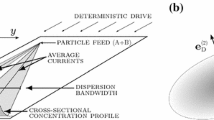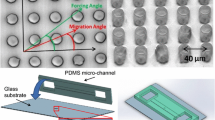Abstract
Deterministic lateral displacement provides a novel and efficient technique for sorting micrometer-sized particles based on particle size. It is grounded on the principle that the paths associated with particles of different diameters, entrained in flow streaming through a periodic lattice of obstacles, are characterized by different deflection angles with respect to the average direction of the carrier flow. Theoretical approaches have been developed, which predict quantitatively the dependence of the average deflection angle on particle size. In this article, we propose an advection–diffusion model for particle transport and investigate the dispersion process about the average particle current, which controls the separation resolution. We show that the interaction between deterministic and stochastic components of particle motion can give rise to enhanced effective dispersion regimes, which may hinder separation far beyond what could be anticipated from the value of the bare particle diffusivity. The large-scale effective diffusion process is typically non-isotropic and is represented by a symmetric second-order tensor whose principal axes are not collinear with the mainstream direction of the carrier flow, or with the average particle current. The enhanced dispersion regimes can be efficiently predicted by a tailored if unconventional implementation of Brenner’s macrotransport paradigm, which amounts to solving a system of two elliptic PDEs on the minimal periodicity cell of the device. The impact of macrotransport parameter on separation resolution is addressed in the concrete case of cylindrical obstacles arranged along a square lattice.


















Similar content being viewed by others
Notes
By the wording “region of locally hindered diffusion” we only denote the subset of the elementary cell where the value of the integration kernel in Eq. (33) is lower than \(\left( \int_{\mathcal{C}} d \mathbf{r} \right)^{-1}.\) Note that this does not mean that initial conditions associated with this region are characterized by a globally hindered diffusion. In fact, regardless of the initial condition, the macroscale diffusion results from the integration of the kernel over the complete volume of the elementary cell.
Abbreviations
- a :
-
Particle radius (Fig. 3)
- \(\mathbf{e}_1, \mathbf{e}_2\) :
-
Lattice vectors (Fig. 1)
- \(\mathbf{r}\) :
-
Intracellular position vector (Fig. 4)
- \(\mathbf{u}(\mathbf{r})\) :
-
Local velocity vector of the carrier fluid
- u(x 1, x 2):
-
Horizontal component of the carrier flow velocity w.r.t. x 1 x 2 axes (Eq. (34))
- v(x 1, x 2):
-
Vertical component of the carrier flow velocity w.r.t. x 1 x 2 axes (Eq. (34))
- \(\mathbf{x}=(x_1,x_2)\) :
-
Global coordinate system aligned with the average carrier flow velocity \(\mathbf{U}\) (Fig. 2a)
- \(\mathbf{x}^*=(x^*_1,x^*_2)\) :
-
Global coordinate system aligned with the lattice vector \(\mathbf{e}_2\) (Fig. 2a)
- \(\mathbf{B}_{\pi}(\mathbf{r})\) :
-
Periodicized (dimensionless) corrector field (Eq. (28))
- D ij :
-
Components of the effective diffusivity tensor \(\mathbb{D}\) projected along the axis x 1 x 2
- D * ij :
-
Components of the effective diffusivity tensor \(\mathbb{D}\) projected along the axis x *1 x *2
- \(\mathbf{J}(\mathbf{r})\) :
-
Dimensionless local particle current (Eq. (29))
- R p :
-
Radius of the cylindrical obstacle, made dimensionless w.r.t. λ (Fig. 6)
- R eff :
-
Dimensionless radius of the effective obstacle, R eff = R p + ρ p (Fig. 6)
- \(\mathbf{U}\) :
-
Average flow velocity
- U :
-
Magnitude of the average flow velocity, \(U= \lVert \mathbf{U} \rVert\)
- \(\mathbf{W}\) :
-
Dimensionless average particle velocity (Eq. (29))
- W i :
-
Components of \(\mathbf{W}\) along the x 1 x 2 axes
- W * i :
-
Components of \(\mathbf{W}\) along the x *1 x *2 axes
- \(\mathbf{X}=(X_1, X_2)\) :
-
Macroscale coordinate system (Fig. 4)
- ϕ :
-
Microscale particle number density function (Eq. 1)
- η, ξ :
-
Local dimensionless coordinates in the unit cell (Fig. 6)
- λ :
-
Characteristic length of the periodicity cell (Fig. 6)
- μ :
-
Dynamic viscosity of the carrier fluid
- ρ p :
-
Dimensionless particle radius, ρ p = a/λ
- θl :
-
Lattice angle (Fig. 1)
- \({\Upphi}\) :
-
Macroscale particle number density function (Eq. 6)
- \({\Uptheta}_{\rm l}\) :
-
Lattice angle parameter \({\Uptheta}_{\rm l}=\tan({\theta}_{\rm l})\)
- \({\Uptheta}_{\rm p}\) :
-
Average particle deflection parameter (Eq. 46)
- \({\Upomega}\) :
-
Region occupied by the cylindrical obstacle in the unit cell domain (Fig. 3)
- \({\Upomega}_{\rm eff}\) :
-
Region occupied by effective obstacle in the unit cell domain (Fig. 3)
- \(\mathcal{D}_{\rm p}\) :
-
Bare particle diffusivity (supposed isotropic), estimated through Stokes–Einstein relationship \(\mathcal{D}_{\rm p}=k_{\rm b} T /( 6 {\pi} a {\mu})\)
- \(\mathbb{D}\) :
-
Macroscale effective diffusivity tensor defined in Eq. (6)
- \(\mathcal{P}(\mathbf{r})\) :
-
Steady-state local zero-th order moment of the particle number density (Eq. 16)
- Pep :
-
Particle Peclét number, \({\rm Pe}_{\rm p}=UL/ \mathcal{D}_{\rm p},\) yielding the ratio between characteristic times of diffusion and convection within the unit cell
References
Al-Fandi M, Al-Rousan M, Jaradat M, Al-Ebbini L (2011) New design for the separation of microorganisms using microfluidic deterministic lateral displacement. Robot Comput-Integr Manuf 27(2):237–244
Balvin M, Sohn E, Iracki T, Drazer G, Frechette J (2009) Directional locking and the role of irreversible interactions in deterministic hydrodynamics separations in microfluidic devices. Phys Rev Lett 103:078301
Brenner H, Edwards D (1993) Macrotransport processes (Butterworth-Heinemann Series in Chemical Engineering, New York 1993)
Cerbelli S (2012) Separation of polydisperse particle mixtures by deterministic lateral displacement. The impact of particle diffusivity on separation efficiency. Asia-Pac J Chem Eng 7(Suppl 3):S356–S371
Dorfman K, Brenner H (2002) Separation mechanisms underlying vector chromatography in microlitographic arrays. Phys Rev E 65(2):021103/1
Edwards D, Shapiro M, Brenner H, Shapira M (1991) Dispersion of inert solutes in spatially periodic, two-dimensional model porous media. Transp Porous Media 6(4):337–358
Fannjiang A, Papanicolaou G (1994) Convection-enhanced diffusion for periodic flows. SIAM J Appl Math 54:333–408
Frechette J, Drazer G (2009) Directional locking and deterministic separation in periodic arrays. J Fluid Mech 627:379–401
Gauthier M, Slater G, Dorfman K (2004) Exact lattice calculations of dispersion coefficients in the presence of external fields and obstacles. Eur Phys J E 15(1):71–82
Ghosh P, Hänggi P, Marchesoni F, Martens S, Nori F, Schimansky-Geier L, Schmid G (2012) Driven Brownian transport through arrays of symmetric obstacles. Phys Rev E 85(1):011101
Gleeson J, Sancho J, Lacasta A, Lindenberg K (2006) Analytical approach to sorting in periodic and random potentials. Phys Rev E 73:041102
Green J, Radisic M, Murthy S (2009) Deterministic lateral displacement as a means to enrich large cells for tissue engineering. Anal Chem 81(21):9178–9182
Grimm A, Grser O (2010) Obstacle design for pressure-driven vector chromatography in microfluidic devices. EPL 92(2):24001
Heller M, Bruus H (2008) A theoretical analysis of the resolution due to diffusion and size dispersion of particles in deterministic lateral displacement devices. J Micromech Microeng 18:075030
Herrmann J, Karweit M, Drazer G (2009) Separation of suspended particles by directional locking in periodic fields. Phys Rev E 79:061404
Holm S, Beech J, Barrett M, Tegenfeldt J (2011) Separation of parasites from human blood using deterministic lateral displacement. Lab Chip 11(7):1326–1332
Huang L, Cox E, Austin R, Sturm J (2004) Continuous particle separation through deterministic lateral displacement. Science 304:987–990
Inglis D, Davis J, Austin R, Sturm J (2006) Critical particle size for fractionation by deterministic lateral displacement. Lab Chip 6:655–658
Inglis D (2009) Efficient microfluidic particle separation arrays. Appl Phys Lett 94(1):013510
Inglis D, Herman N, Vesey G (2010) Highly accurate deterministic lateral displacement device and its application to purification of fungal spores. Biomicrofluidics 4(2):024109
Kirchner J, Hasselbrink E Jr (2005) Dispersion of solute by electrokinetic flow through post arrays and wavy-walled channels. Anal Chem 77(4):1140–1146
Lasota AA, Mackey M (1994) Chaos, fractals, and noise: stochastic aspects of dynamics, vol 97, 2nd edn. Appl Math Sci. Springer, New York
Li Z, Drazer G (2007) Separation of suspended particles by array of obstacles in microfluidic devices. Phys Rev Lett 98:050602
Li N, Kamei D, Ho CM (2007) On-chip continuous blood cell subtype separation by deterministic lateral displacement. Proceedings of the 2nd IEEE International Conference on Nano/Micro Engineered and Molecular Systems, IEEE NEMS 2007, pp 932–936
Long B, Heller M, Beech J, Linke H, Bruus H, Tegenfeldt J (2008) Multidirectional sorting modes in deterministic lateral displacement devices. Phys Rev E 78:046304
Loutherback K, Chou K, Newman J, Puchalla J, Austin R, Sturm J (2010) Improved performance of deterministic lateral displacement arrays with triangular posts. Microfluid Nanofluid 9(6):1143–1149
Maxey M, Riley J (1983) Equation of motion for a small rigid sphere in a nonuniform flow. Phys Fluids 26:883–889
Small H, Lanshorst M (1982) Hydrodynamic chromatography. Anal Chem 54(8):892A–898A
Sun T, Chance R, Graessley W, Lohse D (2004) A study of the separation principle in size exclusion chromatography. Macromolecules 37(11):4304–4312
Author information
Authors and Affiliations
Corresponding author
Rights and permissions
About this article
Cite this article
Cerbelli, S., Giona, M. & Garofalo, F. Quantifying dispersion of finite-sized particles in deterministic lateral displacement microflow separators through Brenner’s macrotransport paradigm. Microfluid Nanofluid 15, 431–449 (2013). https://doi.org/10.1007/s10404-013-1150-8
Received:
Accepted:
Published:
Issue Date:
DOI: https://doi.org/10.1007/s10404-013-1150-8




